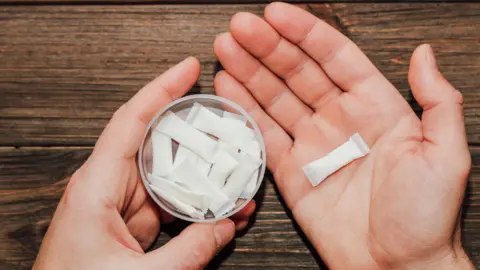**Caffeine Pouch Craze: Concerns Around Teen Usage and Health Implications**
A burgeoning trend among teenagers in the United States observes young individuals gravitating towards caffeine pouches as a convenient means to achieve an energy rush. Health experts are expressing apprehensions that this trend may potentially infiltrate the UK. These small, teabag-like pouches are designed to be placed between the lip and gum, thereby allowing caffeine to enter the bloodstream rapidly.
The appeal of caffeine pouches is notably amplified by social media influencers, who often endorse their use for various purposes, ranging from enhancing athletic performance to helping students maintain alertness during exam periods. Popular platforms, such as TikTok Shop, feature a multitude of brands and flavors targeted towards younger demographics. Health professionals, like Dr. Rob van Dam from George Washington University, warn of the caffeine content in these pouches, which can equate to the caffeine found in two cups of regular coffee. Consequently, the potential for overconsumption and adverse effects is high.
There is an existing concern in the UK regarding younger generations utilizing nicotine pouches and similar products. The discreet nature of caffeine pouches means they can easily go unnoticed, allowing teens to hide usage from parents and educators. Some users have even reported on social media about the “buzz” they experience from using multiple pouches simultaneously for an amplified caffeine high. This rapid absorption, as highlighted by Dr. van Dam, can lead to a swift onset of effects lasting several hours but can also bring about serious health complications, particularly among young people who may have lower tolerance levels for caffeine.
**Understanding Caffeine: Benefits and Risks of Excessive Consumption**
Caffeine serves as a stimulant, enabling individuals to feel more awake and alert by directly influencing the brain and nervous system. According to Lewis James from Loughborough University’s School of Sport, Exercise, and Health Sciences, evidence supports caffeine’s efficacy in making physical exertion seem less daunting, contributing to its popularity among athletes as a performance-enhancing supplement.
Through physical exercise, the body produces adenosine, a chemical responsible for fatigue. Caffeine acts by blocking adenosine receptors, providing a perception of reduced pain and fatigue. However, its effects extend beyond mental alertness; caffeine can influence the cardiovascular system, thereby posing risks. Elevated consumption may result in rapid heart rates, abnormal heart rhythms, and even seizures, with a few documented fatalities attributed to caffeine overdose.
Sensitivity to caffeine varies significantly among individuals. Some may experience side effects like nausea, anxiety, irritability, and headaches even at lower doses. Current guidelines suggest a maximum caffeine intake of approximately 400 mg per day for most healthy adults, equating to roughly four cups of instant coffee. Tea typically contains less caffeine, while children and teenagers are particularly vulnerable to the risks of overdose—with current recommendations advising a maximum of 3 mg/kg body weight.
**Cautionary Measures and Recommendations for Caffeine Consumers**
Dr. van Dam notes the ease with which individuals can reach excessive caffeine levels, as it is present in various drinks and foods. The risk of overdosing becomes more pronounced when combining caffeine pouches with other high-caffeine beverages like energy drinks. He emphasizes the importance of monitoring caffeine consumption, particularly as some products may contain higher caffeine levels than advertised.
Additionally, dental professionals express concerns about prolonged use of caffeine pouches leading to gum irritation, paralleling the effects associated with nicotine pouches. Experts like Bini Suresh from the Cleveland Clinic articulate that while these pouches may appear trendy or innocuous, they carry the inherent risk of normalizing stimulant use among young people, potentially fostering dependency patterns.
Suresh further warns that caffeine, while providing temporary energy boosts, may disrupt sleep and exacerbate fatigue over time—especially in those more susceptible, such as children and teenagers. To promote healthier habits, she advises focusing on balanced diets rich in iron, protein, and slow-release carbohydrates to sustain energy. Instead of resorting to caffeine, young individuals should prioritize regular meals and adequate hydration to maintain overall health and energy levels.
In summary, while caffeine pouches may offer short-term benefits, especially for energy, the long-term health implications and risks—especially for young individuals—should not be overlooked. Responsible consumption and awareness are critical to navigate this modern craze.












